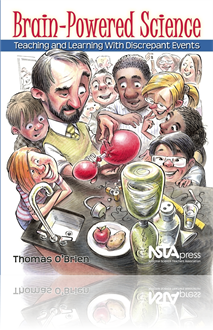All Book Chapters
Book Chapter
Happy and Sad Bouncing Balls: Student Diversity Matters
This activity features two seemingly identical black rubber balls—one happy and one sad—that behave quite differently. The two balls can be used to introduce the National Science Education Standards’ unifying concepts and processes and to rais...
Book Chapter
Electrical Circuits: Promoting Learning Communities
Direct current (DC) electricity flows through a closed circuit of people, and a battery-powered ball lights up. In this activity, the Energy Ball (or UFO Ball) is a Ping-Pong ball look-alike battery-powered ball that produces and converts a small cur...
Book Chapter
Eddy Currents: Learning Takes Time
A metal slug dropped into a copper tube falls under the pull of gravity and drops out at the bottom fairly quickly. When a second, apparently identical, slug is dropped into the tube, it falls quite slowly. If one slug is secretly held in the instruc...
Book Chapter
Cognitive Inertia: Seeking Conceptual Change
Cognitive inertia (or conservatism)—the tendency of humans to continue to think both what and how they have previously thought—applies at both the individual and the scientific community level. This activity features two demonstrations that can b...
Book Chapter
Optics and Mirrors: Challenging Learners' Illusions
Science depends on empirical evidence, logical argument, and skeptical review. Optical illusions challenge us to consider if our eyes sometimes play tricks on us. In this activity, coins dropped into a magic bank appear to shrink in size and fall thr...
Book Chapter
Polarizing Filters: Examining Our Conceptual Filters
If two polarizing filters are placed perpendicular to each other, both horizontal and vertical vibrations will be blocked, allowing little light to be transmitted. In this activity, two polarizing filters are overlaid on an overhead projector. As th...
Book Chapter
Invisible Gases Matter: Knowledge Pours Poorly
Invisible gases are a form of matter that have volume or occupy space. In this activity, water flows down through two identical funnels, each inserted in a two-hole stopper, into two identical flasks. The water flows at very different rates because a...
Book Chapter
The Stroop Effect: The Persistent Power of Prior Knowledge
If learners are asked to state, as fast as they can, the colors of a sequence of words that appear in different colors than the colors named, the first inclination of most is to read the words rather than naming the colors in which the words are prin...
Book Chapter
Rattlebacks: Prior Beliefs and Models for Eggciting Science
In this activity, a translucent, half-ellipsoid-shape, molded acrylic polystyrene object—known as a “rattleback”—is placed on an overhead projector or under a document camera and is observed to spin freely if pushed in a counterclockwise dire...
Book Chapter
Burning a Candle at Both Ends: Classrooms as Complex Systems
This introductory activity models how simple it is to prepare and execute interactive, discrepant-event demonstration-experiments. They can be used daily to activate students’ perceptual attention, catalyze cognitive processing, and energize intere...
Book Chapter
Tornado in a Bottle: The Vortex of Teaching and Learning
In this activity, two 2 L plastic soda bottles are connected at their mouths. Colored water from the upper bottle falls in the lower bottle quickly only after the two bottle system is given a twist to create a spiraling, funnel-shaped vortex. This vi...
Book Chapter
Floating and Sinking: Raising FUNdaMENTAL Questions
Learning science is FUNdaMENTAL—that is, it is a combination of hands-on FUN and minds-on MENTAL activity. It builds on students’ prior knowledge that has been acquired both from formal instruction and from daily life experiences. In this activit...
Book Chapter
Cartesian Diver: A Transparent but Deceptive "Black Box"
An eyedropper “diver”—eyedropper, dropper, diver, and Cartesian diver are used interchangeable in this activity—can be made to float, sink, or remain suspended in the middle of a water-filled, capped, plastic 2 L soda bottle “on command” ...
Book Chapter
Crystal Heat: Catalyzing Cognitive Construction
A small metal clicker/disk within a sealed pouch containing a clear, colorless liquid is clicked, and the liquid rapidly crystallizes into a solid mass and releases a large quantity of heat. If the solidified pouch is allowed to cool back to room tem...
Book Chapter
Perceptual Paradoxes: Multisensory Science and Measurement
Perceptual paradox activities challenge assumptions in ways that are both playful and mentally challenging and that point to the need for quantitative measurements. These activities also demonstrate that human meaning-making always involves both sele...


